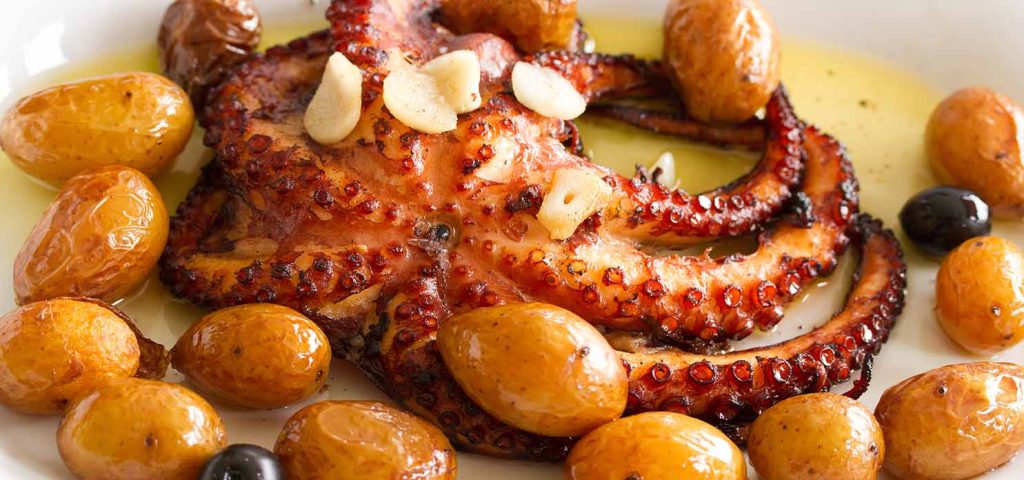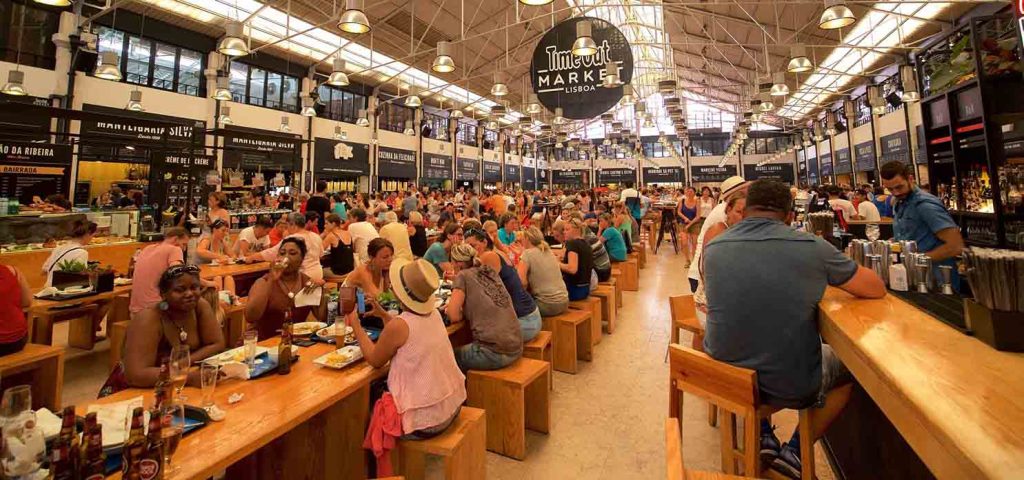When it comes to Portuguese cuisine, many people immediately think of the iconic Pastel de Nata (Portuguese custard tart). However, if you truly find yourself in Lisbon, the capital of Portugal, make sure you don’t stop at just that! This city, built on seven hills, not only offers breathtaking views but also hides countless delicious and story-filled local dishes. From seafood rice to salted cod, from street-side beef sandwiches to octopus salads in local taverns, Lisbon is a city where you can travel through taste.
I’ll take you on a comprehensive “Lisbon Food Map” to explore the city’s soul food with all your senses, from traditional dishes and street food to restaurant recommendations.
1. Starting with the “Pastel de Nata” – The Story Behind Portugal’s National Dessert
Though we say “don’t just eat the pastel de nata,” we can’t skip it entirely. The Pastel de Nata is one of the must-try desserts for every visitor to Portugal. Its origin dates back to the 19th century when it was invented by monks in the Jerónimos Monastery in Belém. Back then, egg whites were used for starching clothes, leaving yolks in surplus—thus giving rise to this creamy, custardy delight.
Over time, the secret recipe was sold to a local bakery, and it eventually gained national and global fame. The tart’s flaky crust and rich custard filling have since become a symbol of Portuguese culinary heritage.
Recommended Place:
- Pastéis de Belém (R. de Belém 84-92)
This is the most authentic birthplace of the pastel de nata. Freshly baked every day, the crispy outer shell and delicate filling are best enjoyed with an espresso. Locals sprinkle a bit of cinnamon and powdered sugar on top—it’s the perfect bite between sightseeing stops in Belém.
2. Bacalhau – The Portuguese National Fish with 1001 Ways to Eat It
In Portugal, Bacalhau (salted cod) is almost synonymous with the national dish. Legend has it that there are 365 ways to cook Bacalhau—one for each day of the year—though some say the number even exceeds 1000. This dried, salted fish has been a culinary staple for centuries, originally used because of its long shelf life during sea voyages. Today, it’s elevated into comfort food and festive dishes alike.
Each recipe brings out a different side of Bacalhau, from creamy and indulgent to light and crispy. It’s common at both family dinners and holiday feasts like Christmas Eve.
Must-Try Dishes:
- Bacalhau à Brás: Shredded cod fish sautéed with onions, matchstick potatoes, eggs, and black olives – a comforting and flavorful Lisbon classic.
- Bacalhau com Natas: Creamy baked cod with onions and béchamel – a rich homestyle dish that melts in your mouth.
- Bolinhos de Bacalhau: Cod fish balls – golden and crunchy on the outside, warm and flaky on the inside, often enjoyed as tapas with a glass of vinho verde.
Recommended Restaurant:
- Zé da Mouraria (Rua João do Outeiro 24)
A traditional family-run spot that’s immensely popular with locals and savvy travelers alike. The portions are generous, the prices are fair, and the cod is always cooked to perfection. Reservations are recommended, especially for dinner.
3. Seafood Paradise – Lisbon’s Must-Try Seafood Dishes
Lisbon, being a coastal city, is renowned for its seafood. Thanks to its proximity to the Atlantic Ocean, seafood here is incredibly fresh—caught in the morning and often served the same day. Whether it’s grilled sardines in a small tavern or lobster rice in an upscale restaurant, Lisbon’s seafood is all about letting the ingredients shine with minimal seasoning and maximum flavor.
Seafood dishes are also deeply embedded in Portuguese culture, celebrated during festivals like the Feast of St. Anthony, when entire streets smell of grilled fish.
Must-Try Seafood:
- Arroz de Marisco: Portuguese seafood rice, brimming with prawns, clams, mussels, and crab. The rice is simmered in a seafood broth, resulting in a juicy, almost soupy texture packed with umami.
- Polvo à Lagareiro: Olive oil-baked octopus roasted with garlic and potatoes. The exterior is lightly crisped, while the inside stays tender—a dish that surprises those who think octopus is tough.
- Amêijoas à Bulhão Pato: Clams sautéed with garlic, olive oil, white wine, and coriander. Light, fragrant, and perfect with crusty bread to mop up the sauce.

Recommended Restaurants:
- Marisqueira Uma (Rua dos Sapateiros 177)
Their seafood rice is famous, as fresh as if it just came out of the sea. - Cervejaria Ramiro (Av. Almirante Reis 1)
Considered one of Lisbon’s best seafood beer houses, even Anthony Bourdain visited this iconic spot.
4. Street Eats and Local Delights – The World of Portuguese Petiscos
Portuguese Petiscos are akin to Spanish tapas, small dishes meant to be shared among friends while sipping drinks.
Must-Try Petiscos:
- Prego no Pão: Beef sandwiches, seasoned with garlic, often served with a cold beer or red wine.
- Chouriço Assado: Flame-grilled chorizo sausage – smoky and full of flavor, perfect with a drink.
- Pastéis de Bacalhau: Cod fish balls – a staple petisco.
Recommended Petisco Taverns:
- Tasca do Chico (Rua do Diário de Notícias 39)
A great place for authentic petiscos, often featuring impromptu Fado performances.
5. The Sweet Universe of Lisbon: It’s More Than Just Pastel de Nata
Beyond the Pastel de Nata, there are many other delightful Portuguese desserts waiting to be discovered.
Recommended Desserts:
- Travesseiros: Puff pastry filled with almond cream, originating from Sintra.
- Queijadas: Small cheese tarts, subtly sweet with a savory note.
- Arroz Doce: Portuguese rice pudding, topped with cinnamon for an aromatic finish.
6. Local Beverages You Can’t Miss
When enjoying Portuguese cuisine, it’s a shame not to accompany your meals with a glass of local wine or spirits.
Wines:
- Vinho Verde: A light, effervescent white wine, perfect for pairing with seafood.
- Ginja (Ginjinha): A cherry liqueur, often served in small shops throughout Lisbon.
- Port Wine: A rich, fortified sweet wine, best enjoyed with desserts.
Coffee Culture: Portuguese people love their coffee, and their styles of coffee are as varied as the country itself.
- Bica: Similar to an espresso.
- Galao: Portuguese latte, a breakfast staple.
7. Delicious Market Finds: Mercado da Ribeira (Time Out Market)
If you want to experience a wide range of Portuguese dishes and creative cuisine all in one place, Time Out Market is undoubtedly one of the best options. This market houses dozens of popular food stalls, including ones by Michelin-star chefs, and local favorites. Whether you crave traditional flavors or wish to explore modern culinary twists, this market offers a feast for the senses.
Time Out Market, originally known as Mercado da Ribeira, is a historical market that dates back to the 19th century. It has been transformed into a modern food hall curated by Time Out magazine. Upon entering, you’ll be greeted by spacious wooden tables, bustling stalls, and an aroma-filled atmosphere, creating a paradise for food lovers.
1. Michelin-Starred Creative Dishes Here, you’ll find stalls from top Portuguese chefs such as Henrique Sá Pessoa, offering signature modern Portuguese dishes like slow-cooked pork neck with red wine sauce, or smoked octopus with olive oil puree – every dish is a work of art. Chef Marlene Vieira focuses on seafood and traditional flavors with creative twists, such as Portuguese-style codfish balls with tomato foam, or air-dried duck breast with bean puree, delivering both visual and culinary enjoyment.

2. Affordable Local Eats The market also has many affordable yet delicious stalls serving traditional dishes such as bifana (pork sandwiches), prego (beef sandwiches), and the ever-popular bacalhau à brás (codfish scrambled eggs). Try O Prego da Peixaria, known for their juicy seafood beef sandwiches, or Cozinha da Felicidade for their hearty beef stew that tastes like a Portuguese home-cooked meal.
3. Seafood Lover’s Heaven How can you come to Lisbon without enjoying its seafood? Time Out Market boasts several seafood stalls such as Marisqueira Azul, which serves fresh oysters, grilled prawns, and octopus, along with the classic Polvo à Lagareiro. If you love soups, try sopa de peixe (fish soup), served with freshly baked bread.
4. More Than Just Pastel de Nata While Pastel de Nata is one of Portugal’s most famous desserts, Time Out Market offers many more local sweets. Try Nós é Mais Bolos for handmade cakes like bolo de bolacha (cookie cake), tarte de amêndoa (almond tart), and pudim Abade de Priscos (a Portuguese pudding with a touch of alcohol). For something with a modern twist, check out L’Éclair, where French éclairs meet Portuguese ingredients.
5. Don’t Miss the Drinks At the center of the market is a spacious bar offering a variety of local Portuguese wines, particularly those from the Douro Valley and Alentejo. Don’t forget to try a glass of Port Wine or the refreshing Vinho Verde, both perfect pairings for the seafood snacks you’ll enjoy at the market.
6. Tips for Visiting
- Opening Hours: The market is typically open from 10 AM to midnight, perfect for a full-day visit.
- Crowds: Avoid peak times between 12:30 PM–2:00 PM and 7:00 PM–9:00 PM, as the market can get quite crowded.
- Payment Methods: Most stalls accept credit cards and electronic payments, though some smaller vendors may only take cash, so it’s a good idea to bring some change.
Time Out Market is more than just a place to eat; it’s a cultural and gastronomic experience. Each dish tells a story of Portuguese heritage, and all you need to do is bring an open mind and a hungry stomach to savor every bite.